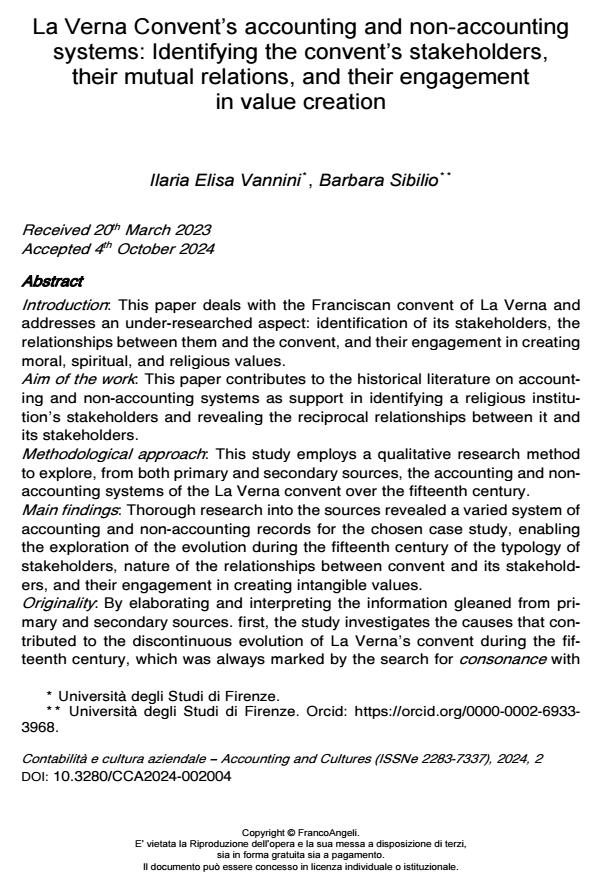La Verna Convent’s accounting and non-accounting systems: Identifying the convent’s stakeholders, their mutual relations, and their engagement in value creation
Journal title CONTABILITÀ E CULTURA AZIENDALE
Author/s Ilaria Elisa Vannini, Barbara Sibilio
Publishing Year 2024 Issue 2024/2
Language English Pages 60 P. 59-118 File size 573 KB
DOI 10.3280/CCA2024-002004
DOI is like a bar code for intellectual property: to have more infomation
click here
Below, you can see the article first page
If you want to buy this article in PDF format, you can do it, following the instructions to buy download credits

FrancoAngeli is member of Publishers International Linking Association, Inc (PILA), a not-for-profit association which run the CrossRef service enabling links to and from online scholarly content.
Introduction: This paper deals with the Franciscan convent of La Verna and addresses an under-researched aspect: identification of its stakeholders, the relationships between them and the convent, and their engagement in creating moral, spiritual, and religious values. Aim of the work: This paper contributes to the historical literature on accounting and non-accounting systems as support in identifying a religious institution’s stakeholders and revealing the reciprocal relationships between it and its stakeholders. Methodological approach: This study employs a qualitative research method to explore, from both primary and secondary sources, the accounting and nonaccounting systems of the La Verna convent over the fifteenth century. Main findings: Thorough research into the sources revealed a varied system of accounting and non-accounting records for the chosen case study, enabling the exploration of the evolution during the fifteenth century of the typology of stakeholders, nature of the relationships between convent and its stakeholders, and their engagement in creating intangible values. Originality: By elaborating and interpreting the information gleaned from pri- mary and secondary sources. first, the study investigates the causes that contributed to the discontinuous evolution of La Verna’s convent during the fifteenth century, which was always marked by the search for consonance with its stakeholders of moral, spiritual and religious interests and expectations. Second, it addresses a less-explored aspect: identifying the convent’s ‘active’ stakeholders, compilation of two lists of stakeholder groups related with the convent, and construction of two stakeholder maps, both lists and maps referring to the beginning and the end of the fifteenth century. Third, the study identifies the predominantly intangible values created and achieved by the convent and its stakeholders as a result of reciprocal relationships. As a novel contribution, a matrix was drawn, which, in qualitative terms and with reference to the end of the 1400s, provides multiple values generated by the relations between the convent and its stakeholders.
Keywords: La Verna convent, stakeholder, stakeholder map, accounting and non-accounting system, matrix intangible values
Ilaria Elisa Vannini, Barbara Sibilio, La Verna Convent’s accounting and non-accounting systems: Identifying the convent’s stakeholders, their mutual relations, and their engagement in value creation in "CONTABILITÀ E CULTURA AZIENDALE" 2/2024, pp 59-118, DOI: 10.3280/CCA2024-002004